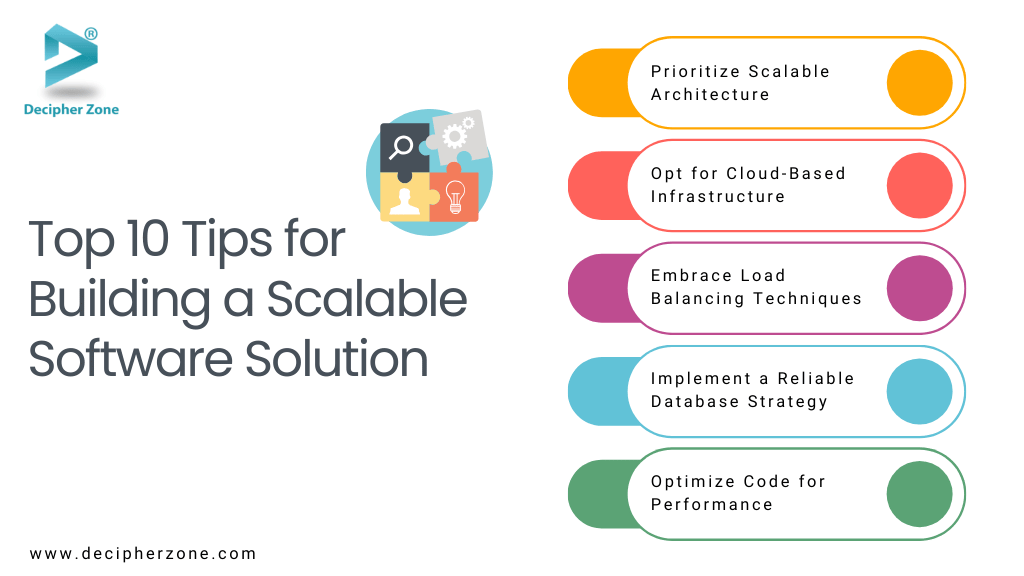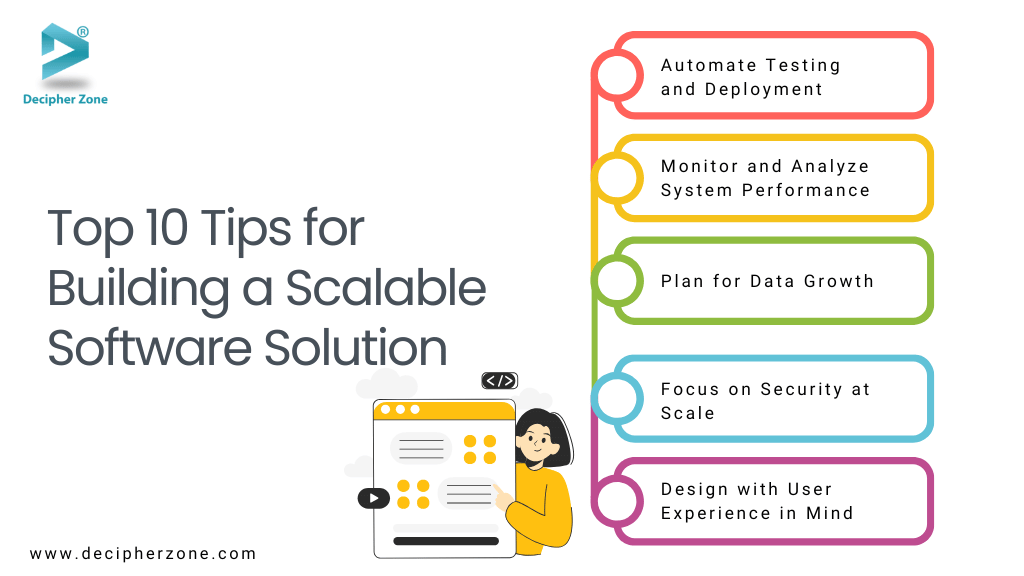Explore tips for creating scalable software solutions, whether you're starting a new project, or looking to grow your business, you'll find the guidance you need. Upscale your software solution with the help of experts‘ strategies.
This guide provides the essential insights and actionable tips you need to ensure sustainable growth and success. Don’t miss the opportunity to build a future-ready software solution that adapts seamlessly to changing demands.
Are you aware of why 88% of users are less likely to revisit a website after a bad experience?
This staggering statistic from a study on user behavior highlights that performance and reliability are the most crucial elements. For businesses relying on software solutions, scalability is the linchpin to delivering that stellar experience, even under high demand.
Businesses turn to scalable solutions when unexpected demand spikes arise to avoid downtime, dissatisfied customers, and potential revenue losses. With a wide range of options, users expect smooth uninterrupted interactions with software.
Wondering how to ensure your software evolves seamlessly with growing user demands and increasing data volume? The answer lies in designing and implementing a scalable software solution from the beginning. This blog is dedicated to tips to help you build scalable software solutions.
What is Scalable Software and Why Does it Matter?
Scalability is the ability to upscale the capabilities of your software without compromising on quality or efficiency. Imagine your software as a restaurant: scalability determines whether your kitchen can serve a bustling dinner crowd just as effectively as a quiet lunch hour.
The key question is why scalability is important for businesses. Companies strive to:
-
Improve performance,
-
Ensure future readiness,
-
Achieve cost efficiency.
10 Expert Tips for Building a Scalable Software Solution in 2025
Let’s get you to the top 10 tips to upscale your software in 2025 that can handle the pressure as your business evolves. Scalability is paramount and a fundamental necessity. As your user base grows, so too will the demands on your system.
1. Prioritize Scalable Architecture from the Start
The architecture of your software sets the stage for how it will grow. If you don’t plan for scalability from the start, you will face roadblocks when it is time to expand. Choosing scalable frameworks such as Node.js, Django, or Spring Boot that support high concurrency and distributed systems.
By laying the right architectural foundation, you are setting up your software for success, ensuring it can handle future growth without costly rework or downtime.
2. Opt for Cloud-Based Infrastructure
Cloud computing has revolutionized scalability by offering flexible, on-demand resources. With features like auto-scaling, your system can automatically add or reduce resources (like server capacity) to handle traffic surges or decreases, ensuring consistent performance.
Unlike traditional server setups, cloud services enable you to scale your infrastructure seamlessly based on real-time needs.
Leading cloud providers including AWS, Azure, and Google Cloud offer robust solutions designed to support massive scaling without the hassle of managing physical hardware. By adopting cloud infrastructure, you gain reliability, cost-efficiency, and the ability to scale at your own pace.
3. Embrace Load Balancing Techniques
Without load balancing, high traffic can lead to delays or system crashes. To ensure your software performs well under varying loads, effective load balancing is essential.
This technique distributes incoming traffic across various servers, preventing any single server from becoming overwhelmed.
Tools like NGINX and HAProxy are widely used for efficient load distribution, while cloud providers like AWS offer their own managed load-balancing services.
By implementing load balancing, you can ensure that no matter how much traffic hits your application, performance remains consistent and responsive.

4. Implement a Reliable Database Strategy
Strategies like indexing, partitioning, and caching can significantly boost performance. Indexing speeds up queries, partitioning divides data into smaller, manageable parts, and caching reduces the load on the databases by storing frequently accessed data.
When building scalable software, your database must grow as your data expands. Some databases allow them to efficiently manage vast amounts of data across multiple servers. Together, these strategies help your database scale without sacrificing performance or speed.
5. Optimize Code for Performance
Writing clean, efficient, and maintainable code ensures your software can scale with minimal friction as the quality of your code directly impacts scalability.
By utilizing asynchronous programming (where tasks run concurrently rather than sequentially), you can prevent bottlenecks that slow down performance during high-load periods.
Avoiding unnecessary complexity and focusing on efficiency reduces resource consumption and enhances system responsiveness, ensuring the software can handle growing user demand without faltering
6. Automate Testing and Deployment
Automated testing is essential for maintaining scalability as a system expands. It ensures that new features or updates don’t bring about performance issues, making it increasingly important.
Continuous integration (CI) and continuous deployment (CD) pipelines help streamline updates, ensuring that new code integrates seamlessly into the system.
When scaling software, consistency, and reliability are paramount. This enables faster delivery of updates while reducing the risk of introducing bottlenecks or errors that could compromise performance during scaling.
7. Monitor and Analyze System Performance
Tools like New Relic, Datadog, and Prometheus provide real-time insights into system performance, alerting you to any potential issues before they impact users. To ensure scalability remains intact as your software grows, continuous monitoring is essential.
Set up automated alerts for performance blockage or unexpected traffic spikes to identify problems early and address them before they escalate. Regular analysis can help you stay ahead of scalability challenges and ensure the software runs smoothly at all times.
8. Plan for Data Growth
By designing systems that can handle increasing data volume through techniques. As the software scales, so does the data it generates. Planning ahead for data growth is crucial to maintain performance without overwhelming infrastructure.
With data partitioning and disturbed databases, you can ensure smooth scalability. You can use data warehousing and archiving strategies to store older data in more cost-effective locations, freeing up space for real-time processing and maintaining system procedures.

9. Focus on Security at Scale
As the software scales, security needs to evolve. With more users, transactions, and data, you need to ensure robust security becomes even more crucial. By implementing strong authentication mechanisms, encryption, and data compliance protocols to protect user data at every scale.
Security features like multi-factor authentication (MFA), role-based access control (RBAC), and end-to-end encryption help safeguard the application against vulnerabilities. A security-first approach makes sure that your software grows and remains secure and trustworthy for users.
10. Design with User Experience in Mind
As you scale, you need to ensure that the software remains fast, responsive, and easy to use. Scalability should never come at the expense of user experience. Integrate adaptive design where the software dynamically adjusts to different screen sizes and device types. This ensures the software solution performs optimally across platforms.
Prioritizing speed as a slow software solution will drive users away regardless of its scalability. By designing with the user in mind, you can make sure that scalability doesn’t just keep the system running, it keeps it delightful to use, neglecting the user base.
Final Thoughts
Scalability is much more than just growth; it’s about creating software solutions that adapt alongside users while ensuring top-notch performance. By following these tips for building scalable software, you can elevate your business to new heights.
However, to truly succeed, bringing in experts is essential. That’s where Decipher Zone comes in.
Our skilled developers are ready to help you craft a scalable software solution customized to meet your specific business needs and designed to grow as your user base expands.

Frequently Asked Questions
-
How do I determine if my software solution is scalable?
Scaling can be ensured by keeping the tips in mind while developing software solutions from the start. The tips are to Prioritize Scalable Architecture from the Start, Opt for Cloud-Based Infrastructure, Embrace Load Balancing Techniques, Implement a Reliable Database Strategy, Optimize Code for Performance, Automate Testing and Deployment, and Monitor and Analyze System Performance.
-
What are the key challenges in building scalable software?
Mostly businesses face challenges in choosing the right architecture and tools, managing growing data volumes efficiently, ensuring security measures evolve with scalability, and balancing performance with cost.
-
Can existing software be made scalable, or do I need to rebuild it?
Existing software solutions can be made scalable but rebuilding might be necessary in extreme cases, however, some scalable strategies can help including, Refactoring the code, Migrating to cloud-based infrastructure, Implementing load balancers, and optimizing the database.

